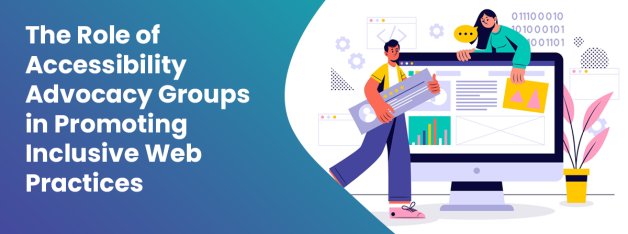The Role of Accessibility Advocacy Groups in Promoting Inclusive Web Practices

The internet is a gateway to knowledge, services, and opportunities. But for millions of users with disabilities, navigating web pages can be an uphill battle due to poor design choices, lack of keyboard navigation, and low color contrasts. Accessibility advocacy groups play a crucial role in ensuring that digital spaces are welcoming for everyone.
By championing the Web Content Accessibility Guidelines (WCAG), influencing policies like the Americans with Disabilities Act (ADA), and collaborating with the World Wide Web Consortium (W3C), these organizations work toward a more inclusive web. This blog explores how these groups drive change and what businesses can do to create accessible websites that improve user experience for all.
Why Web Accessibility Matters
Imagine walking into a building with no ramps or elevators—only staircases. Now, apply that analogy to the digital world. Many web pages are built without considering users with visual impairments, mobility challenges, or cognitive disabilities. The result? Millions of people face accessibility issues that prevent them from accessing essential online services.
The impact is widespread:
- Legal Compliance: The Americans with Disabilities Act (ADA) requires businesses to offer digital accessibility, just like physical accommodations.
- Improved User Experience: A well-designed site benefits everyone, not just those with disabilities. Enhanced keyboard navigation, clear color contrasts, and intuitive layouts make browsing smoother.
- Expanded Audience Reach: Businesses risk excluding a significant portion of potential customers by neglecting accessibility.
Now, let’s explore the key players advocating for a more inclusive web.
Leading Accessibility Advocacy Groups and Their Impact
1. World Wide Web Consortium (W3C) – The Backbone of Accessibility Standards
The World Wide Web Consortium (W3C), an international organization that sets web standards, leads the development of the Web Content Accessibility Guidelines (WCAG). These guidelines provide a framework for designing accessible websites that cater to people with diverse abilities.
Key Contributions:
- Developed WCAG 2.1, the gold standard for web accessibility.
- Ensures that modern technologies support accessibility features like keyboard navigation and screen reader compatibility.
- Works with governments and businesses to implement accessibility best practices.
Why It Matters:
Without W3C’s efforts, accessibility would be a subjective, optional feature rather than a structured standard. Businesses that follow WCAG guidelines significantly reduce accessibility issues on their websites.
2. WebAIM – Making Accessibility Understandable
WebAIM (Web Accessibility In Mind) is a nonprofit dedicated to simplifying accessibility implementation for developers and designers.
Key Contributions:
- Provides free accessibility testing tools to identify issues in web pages.
- Educates businesses and web professionals on color contrasts, alt text, and proper HTML structure.
- Advocates for policy changes to make the internet more inclusive.
Why It Matters:
WebAIM bridges the gap between accessibility theory and practical application, helping businesses create highly accessible websites without overwhelming complexity.
3. National Federation of the Blind (NFB) – Advocating for the Visually Impaired
For people with visual impairments, a lack of screen reader compatibility or poor color contrasts can render a website unusable. The National Federation of the Blind (NFB) fights for digital accessibility through legal advocacy and public awareness.
Key Contributions:
- Took legal action against major companies failing to meet ADA web accessibility requirements.
- Works with businesses to develop user experience standards for visually impaired users.
- Provides resources on using assistive technology effectively.
Why It Matters:
Through NFB’s efforts, more websites are adopting features like screen reader compatibility and keyboard navigation, making the web more inclusive.
4. The American Association of People with Disabilities (AAPD) – Policy and Legal Action
The Americans with Disabilities Act (ADA) extends beyond physical spaces—it applies to digital experiences as well. The AAPD plays a crucial role in ensuring that businesses and governments recognize this.
Key Contributions:
- Drives policy changes that mandate digital accessibility in public and private sectors.
- Supports litigation against companies failing to create accessible websites.
- Collaborates with tech companies to design more inclusive platforms.
Why It Matters:
Without policy enforcement, businesses might overlook accessibility. AAPD ensures compliance is not optional.
Key Principles of Inclusive Web Design
To build accessible websites, businesses should integrate these core practices:
1. Keyboard Navigation Over Mouse-Only Interactions
Not all users rely on a mouse. Many navigate web pages using keyboard navigation or assistive devices. Ensuring that all interactive elements—buttons, links, and forms—are accessible via the keyboard is essential.
Example: A user with motor impairments should be able to fill out a contact form and submit it using only the Tab and Enter keys.
2. Strong Color Contrasts for Readability
Poor color contrasts make text difficult to read, especially for users with visual impairments or color blindness. WCAG recommends a contrast ratio of at least 4.5:1 for standard text and 3:1 for larger text.
Example: Black text on a yellow background is readable, whereas light gray text on a white background is not.
3. Descriptive Alt Text for Images
For visually impaired users, images without descriptions create gaps in content understanding. Alt text (alternative text) allows screen readers to convey what an image represents.
Example: Instead of “image1.jpg,” an accessible site would use “A woman using a screen reader on a laptop” as the alt text.
4. Clear, Predictable Structure
A well-organized website improves user experience for everyone. Proper heading hierarchies, consistent navigation, and simple forms reduce accessibility issues.
Example: Instead of cluttered text blocks, using headings (H1, H2, H3) and bullet points makes scanning easier.
5. Compliance with Web Content Accessibility Guidelines (WCAG)
The Web Content Accessibility Guidelines (WCAG) set clear standards for accessible websites. Following these guidelines ensures that web experiences are designed with inclusivity in mind.
Example: A website adhering to WCAG 2.1 would include captions for videos, resizable text, and proper heading structures.
The Future of Web Accessibility
Accessibility isn’t just a legal requirement—it’s a fundamental aspect of ethical web design. As technology advances, advocacy groups will continue pushing for:
- AI-powered accessibility tools that detect accessibility issues in real time.
- Greater enforcement of Americans with Disabilities Act (ADA) regulations for digital spaces.
- Industry-wide adoption of World Wide Web Consortium (W3C) standards.
Businesses that prioritize accessibility will not only comply with regulations but also enhance user experience and expand their audience reach.
Final Thoughts
Web accessibility advocacy groups are shaping a more inclusive digital landscape. By following their lead and adopting best practices, businesses can ensure that their web pages are usable by everyone, regardless of ability. The future of the web is inclusive—are you ready to be a part of it?
